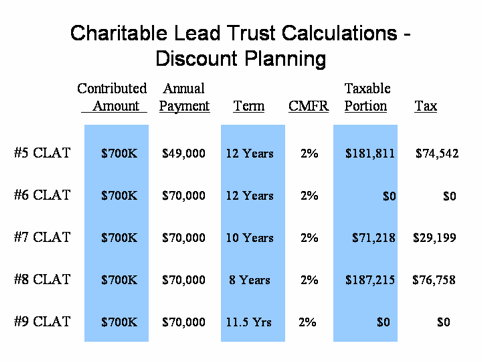

Technical - Discount Planning and CLTs
Charity Advisor Resource Newsletter - Volume 1.1 (2009)
BY JONATHAN D. ACKERMAN
One must analyze the economics of gifting a discountable asset to a CLT to understand the benefits.
When reviewing the chart below, please note that the first column represents the fair market value of the asset contributed to the CLT; the second column is the annual payout from the CLT to the charity; the third column is the term of the CLT; the fourth column is the charitable mid-term federal rate ("CMFR" - the plug number, for the month in which the CLT is created, that the IRS dictates be used for this present value calculation - 120% of the applicable mid-term federal rate, rounded to the nearest 2/10ths of a percent - which is published monthly and mandated by Code Section 7520); the fifth column is the taxable portion of the gift - that portion of the value of the contributed asset that is attributable to the gift to the remainder beneficiary, which would thus constitute a taxable gift; and the sixth column is the tax attributable to such a gift (assuming a gift tax would be imposed).
Please note that #5 CLAT assumes that no discountable asset is contributed to the trust - let's say, just cash in the amount of $700,000, for a term of 12 years with a 7% payout and a CMFR of 2%, which will render a taxable portion of $181,811. However, in #6 CLAT, the assumption is that a limited partner interest in a family limited partnership (FLP) is contributed to the CLAT, where the underlying assets of the FLP are worth $1 Million, but a 30% discount is applied to such FLP interest. #6 CLAT illustrates a very significant point - the taxable portion (and the corresponding tax) will be eliminated due to the increased payout (7% of $1 Million, or $70,000) which can be produced from the $1 Million of assets owned by the FLP. Thus, the discount in value of an FLP interest provides greater leverage for determining the payout rate in proportion to the value of the FLP's underlying assets.
#7 CLAT and #8 CLAT illustrate that the term of the CLAT can be significantly reduced with a corresponding impact on the taxable gift portion. #9 CLAT illustrates that the term of approximately 11.5 years is when the taxable portion of the remainder gift in the CLT is zeroed out.
It is also important to remember that the taxable portion from the CLT gift can be reduced or eliminated by applying any unused gift tax exemption amount.
In addition, a donor to a CLT may elect the CMFR in the month of the CLT's creation or the CMFR for the two months preceding the CLT's creation. For instance, a donor creating a CLT in the month of April, 2009, may elect the CMFR for the month of February. Since February's CMFR was 2.0%, an historic low, creating a CLT by April, 2009 (and electing to use February's CMFR) is the most favorable economic calculation of present value to date.
PLEASE ALSO NOTE THAT THE CMFR FOR A PARTICULAR MONTH IS PUBLISHED BY THE TREASURY ON OR AROUND THE 20th OF EACH MONTH. THUS, IF THE DONOR WAITS TO CREATE THE CLT UNTIL AFTER APRIL 2OTH, THE DONOR WILL EFFECTIVELY HAVE 4 MONTHS (FEBRUARY, MARCH, APRIL & MAY) TO CHOOSE THE MOST FAVORABLE CMFR FOR THE PURPOSE OF CREATING THE CLT.
IT IS ASSUMED IN THE CHART THAT EACH CLT IN THESE EXAMPLES IS A NON-GRANTOR CLT CREATED FOR THE PURPOSE OF MINIMIZING OR AVOIDING THE ESTATE AND GIFT TAXATION.
CHART ON THE ECONOMICS OF A GIFT OF A DISCOUNTABLE ASSET TO A CLT:
As can be gleaned from this spreadsheet, the term of the CLT and/or the annual payment from the CLT to the charity can be altered. These factors will ultimately impact the taxable portion of the CLT. So, the donor in an inter vivos CLT can dictate when his or her heirs will receive the assets of the CLT and the amount to be paid out to charity, considering the nature of the assets being contributed to the CLT.
By using discountable assets to fund the CLT, a larger payout can be made based upon its discounted value, which will provide the donor with greater flexibility in determining the term of the CLT and the ultimate taxable portion. There are a variety of assets, other than a FLP interest, that may be discounted for estate and gift tax purposes due to their nature, such as a fractional interest in real estate or an under-collateralized Promissory Note.
Click here to read the Featured Article What's Hot Now! for a discussion of the impact of the current low interest rate environment.
But don't forget that interest rates even after April of 2009 remain at historic lows, so the benefits discussed in this Article still apply. There are, of course, a variety of tax, financial and estate planning benefits associated with a gift to a CLT, as described above. In addition, by creating an inter vivos CLT, donors can develop and implement their philanthropic vision during their lifetime and experience firsthand the power of philanthropy in bettering the lives of others.
However, the CLT is a sophisticated gift planning vehicle, and as with all such vehicles, professional counsel should be retained to fully analyze the effectiveness of a particular vehicle given a particular set of circumstances.

Jonathan Ackerman, 2002 President of NCPG (now known as Partnership for Philanthropic Planning), represents donors and tax-exempt organizations on a national basis. His advice is often sought by charities in their creation and operation, especially with respect to contributions and other funding opportunities, as well as by families (and their advisors) who desire to integrate philanthropy into their estate plans.